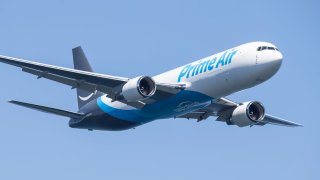
- Amazon on Wednesday debuted its $1.5 billion air hub in northern Kentucky.
- The hub will serve as the central nerve of Amazon's U.S. air cargo operations, allowing it to speed deliveries even further to more corners of the country.
Amazon on Wednesday opened its $1.5 billion air hub in northern Kentucky, which will help accelerate its push for faster delivery and greater control over its logistics network.
It's a major milestone for Amazon Air, the company's burgeoning air cargo arm that launched in 2016, whose routes are flown by several contracted carriers. Across the company's sprawling network of warehouses, trucks and delivery vans, planes remain a critical piece of the puzzle in ensuring packages can be handed off quickly to customers' doorsteps.
Amazon Air operates out of more than 40 airports across the U.S., but the terminal at Cincinnati/Northern Kentucky International Airport will serve as the central nerve of its nationwide cargo network. It will allow Amazon to supercharge its one-day and, increasingly, same-day delivery capabilities in more areas of the country. Amazon has also expanded its aviation logistics unit beyond the U.S., opening a 20,000-square-meter regional air hub at Leipzig/Halle Airport in Germany last November.
Get San Diego local news, weather forecasts, sports and lifestyle stories to your inbox. Sign up for NBC San Diego newsletters.
The Kentucky hub — which is just a short drive from Cincinnati, Ohio — has been in development for more than four years. Amazon founder and executive chairman Jeff Bezos, then CEO, broke ground on the project in 2019 by hopping into a John Deere front loader to "move some earth."
At the time, Bezos remarked: "This hub is going to let us get packages to customers faster. That's a big deal."
Money Report
The hub spans a campus of over 600 acres. It includes a ramp for aircraft parking, a multilevel parking structure and seven buildings. Amazon also included an 800,000-square-foot robotic sort center, where packages are sorted by zip code and consolidated into trucks before delivery.
Analysts have eagerly awaited the hub's launch because of its potential to significantly speed deliveries, and help Amazon catch up to carriers such as UPS and FedEx. A report issued last fall by DePaul University's Chaddick Institute for Metropolitan Development described the hub as the "lynchpin to Amazon's efforts to develop a comprehensive array of domestic delivery services across the United States."
It's designed to have capacity for 100 Amazon-branded planes and handle an estimated 200 flights per day, telegraphing Amazon's ambitions to bring more of its air cargo operations in house. Investors have questioned whether Amazon will offer its air cargo services to other companies as a way to generate new revenue streams.
For now, Amazon Global Air vice president Sarah Rhoads said the company is focused on handling its own package volume.
"Right now, we're focused on our customers for sure," Rhoads said in an interview with CNBC. "We built the hub in Cincinnati to serve our Amazon customers, there's really no other purpose than that."
Amazon Air now has more than 75 aircraft in the network, and the company expects to have more than 80 planes at this time next year and 85, both leased and owned, by the end of 2022.
Atlas Air Worldwide Holdings and Air Transport Services Group are among Amazon Air's operators. Last year, low-cost leisure passenger airline Sun Country began flying converted Boeing 737s for Amazon, a welcomed revenue source during the depths of the pandemic when many travelers stayed home.
In January, Amazon acquired 11 used Boeing 767-300 jets from Delta and WestJet, its first-ever outright aircraft purchase as prices for planes fell in the pandemic.
"We're learning a lot as a company through this process of owning and working through the conversion of aircraft," Rhoads said. "A lot of it comes down to availability of feedstock and what makes the most sense for our network and our customers as well."
When asked whether Amazon would expand the number of airlines that fly its air network, or own an airline outright, Rhoads said that the company is focused on the current partners and model.
"We are becoming a fairly big network and we're happy with the service that we're getting right now," she said.






